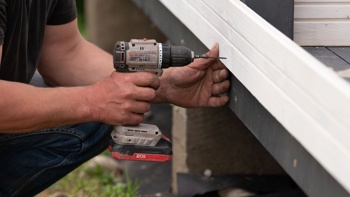One of the easiest ways to make a difference in the climate emergency is composting your organic waste rather than throwing it in your rubbish bin
Organic matter in your rubbish goes into the landfill where is starts composting in amongst your paper and plastic waste. This causes methane to build up, which is a strong greenhouse gas, and can also reintroduce some of the nasty chemicals and heavy metals back into our environment. Not good.
If you have no room you can use a worm farm or bokashi bin. Jack has been using a worm bin for years in his balcony garden
Today we will talk about a backyard compost
Many people are a bit afraid or concerned that it will take too much time to compost and be messy. Let’s talk about how easy, and in the end satisfying, composting can be
What do you need
First of all find a handsome closable container that can sit on your bench and take all the scraps as you prepare your meals and then scrap off your plates after eating. We also have a larger bin on the floor that operates by a foot action to open the lid,. This is for bigger meals, corn and harvest season and when you have visitors and are eating a lot of food.
A garden fork is handy to own and best for turning the compost
Collect green materials, usually grass clippings , coffee grounds and if available manure from horses, cows, chickens or sheep. These are high nitrogen additives that will kick start the microbes breaking down your waste. The green items also include your kitchen waste including egg shells, tea leaves etc.
For your brown materials wood chips from the local garden contractors are perfect. Other “brown” options include shredded cardboard, dried leaves, straw or hay, all of which should be well mixed with other items so they don’t compact and impede air flow.
Then find a space in your yard for the bin, preferably in the shade. Bins come in many shapes and sizes. Find one that suits your habits and space
Compost requires four main ingredients: water, oxygen, nitrogen — from “green” items — and carbon — from “brown” items
A compost pile should be damp, like a squeezed-out sponge, but not dripping, and the more often you turn it and give it oxygen, the faster the microbes can break the materials down to an earthy-smelling, chocolate-brown amendment for your soil. You don’t have to turn it at all, but it will take much longer for all the materials to break down.
1. Start with a 8 to 15cm layer of untreated wood chips or small broken branches at the bottom of a bin or just on the ground. This will help absorb odours and provide air circulation.
2. Add a 8cm layer of green or nitrogen items, such as vegetable trimmings and eggshells.
3. Add a 3cm layer of a high-nitrogen activator such as manure, brew waste or coffee grounds. If you use grass clippings, make sure to mix them in with other items so they don’t compact.
4. Add a 8cm layer of brown or carbon ingredients, such as wood chips, shredded newspaper or cardboard, straw or hay, pine needles or dry leaves (well mixed with other ingredients so they don’t mat).
5. Water those layers well so the pile is thoroughly wet, and if you have enough ingredients, repeat the same layering process, watering again to ensure all the ingredients get wet.
6. Turn the pile monthly by forking ingredients from the bottom of the pile to the top. When you add food scraps, cover them with wood chips or some other brown material to absorb odours and deter pests, but try to keep an even balance of greens and browns and make sure the pile stays moist. If the pile gets too dry, decomposition slows and it’s more likely to attract ants and other pests. Add more greens and water, and turn. If the pile starts smelling or gets too wet, add more brown carbon material and mix it well.
7. Once you fill a bin, let it “cook” for a few months (turning it monthly will speed the process) and start a second bin or pile nearby so you always have a place to add your food waste.
If you are in an area with a rat problem then I suggest you leave out items that would be delicious to them. Like bread, rice or other starches. These can be put in a bokachi or worm bin
Also until you know you are getting a really hot compost it is best to add meat products to these other bins as well even if you don’t have rats.
In these examples you will probably need a second bin in your kitchen
Once ready you have the best thing possible for your outdoor planting. It can be used when you plant or just as the best possible mulch for any situation. It will retain moisture, keep out weeds, protect the soil and then the worms will take it down and incorporate it into your soil. The first organic movement in NZ called themselves the ,Compost Club.
At the eco village I’m currently using a smaller container for my coffee grounds , eggshells , tea, citrus and avocados. That is because everything else goes straight to my chickens. Called a deep litter system where the chicken make the compost for you and you can even add weeds as the chickens will eat all the weed seeds Then I have a large system made of old pallets for a straight compost of cow manure, seaweed, biochar and lawn clippings.
Look out, because composting can become quite addictive.
LISTEN ABOVE
Take your Radio, Podcasts and Music with you










